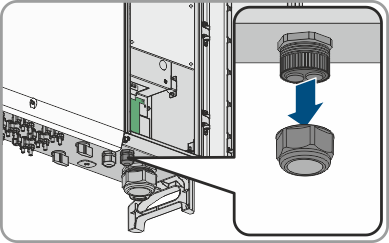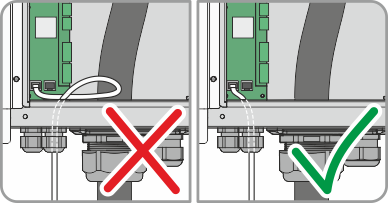Connecting the Network Cables
 Qualified person
Qualified person
 DANGER
DANGER
Danger to life due to electric shock in case of overvoltages and if surge protection is missing
Overvoltages (e.g., in the event of a flash of lightning) can be further conducted into the building and to other connected devices in the same network via the network cables or other data cables if there is no surge protection. Touching live parts and cables results in death or lethal injuries due to electric shock.
- Ensure that all devices in the same network are integrated in the existing overvoltage protection.
- When laying the network cable outdoors, ensure that there is suitable surge protection at the network cable transition from the product outdoors to the network inside the building.
Additionally required material (not included in the scope of delivery):
Network cable
Where required: Field-assembly RJ45 connector.
Procedure:
- Open the cable compartment ( > Opening the Cable Compartment).
- When using a self-assembly network cable, assemble the RJ45 connectors and connect them to the network cable (see connector documentation).
- Remove the swivel nut from one of the cable glands for the communication cable.
- Thread the swivel nut over the network cable.
- Remove the two-hole cable support sleeve from the cable gland. As required, use the cable support sleeve for a cable diameter of between 4.5 mm to 6 mm or between 6 mm to 8 mm that is included in the scope of delivery.
- Remove the sealing plug from one of the enclosure openings of the two-hole cable support sleeve and insert the network cable into the enclosure opening.
- Press the two-hole cable support sleeve with the cable into the cable gland and route the network cable to the RJ45 connection at the bottom of the cable compartment. Ensure that any unused enclosure openings of the two-hole cable support sleeve are sealed with sealing plugs.
- Put the RJ45 plug of the cable into one of the network jacks of the communication assembly.
- Ensure that the network cable does not form any loops in the device and is no longer than necessary.
- Ensure that the RJ45 connector is firmly seated and that there is no tension on the cable.
- Tighten the swivel nut on the cable gland hand-tight. This will secure the network cable in place.
- If the inverter is installed outdoors, install overvoltage protection for all components in the network.
- To integrate the inverter into a local network, connect the other end of the network cable to the local network (e.g. via a router).




Also see:
